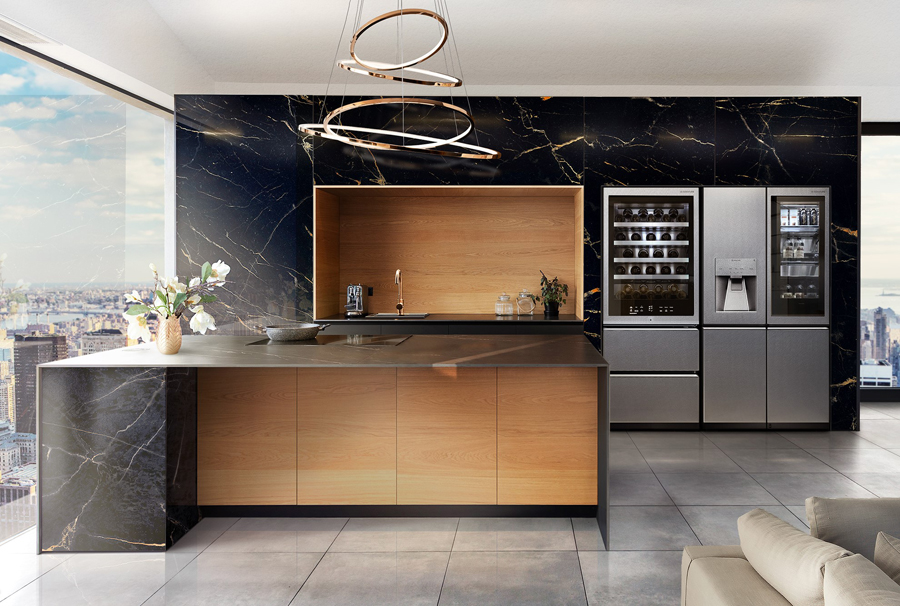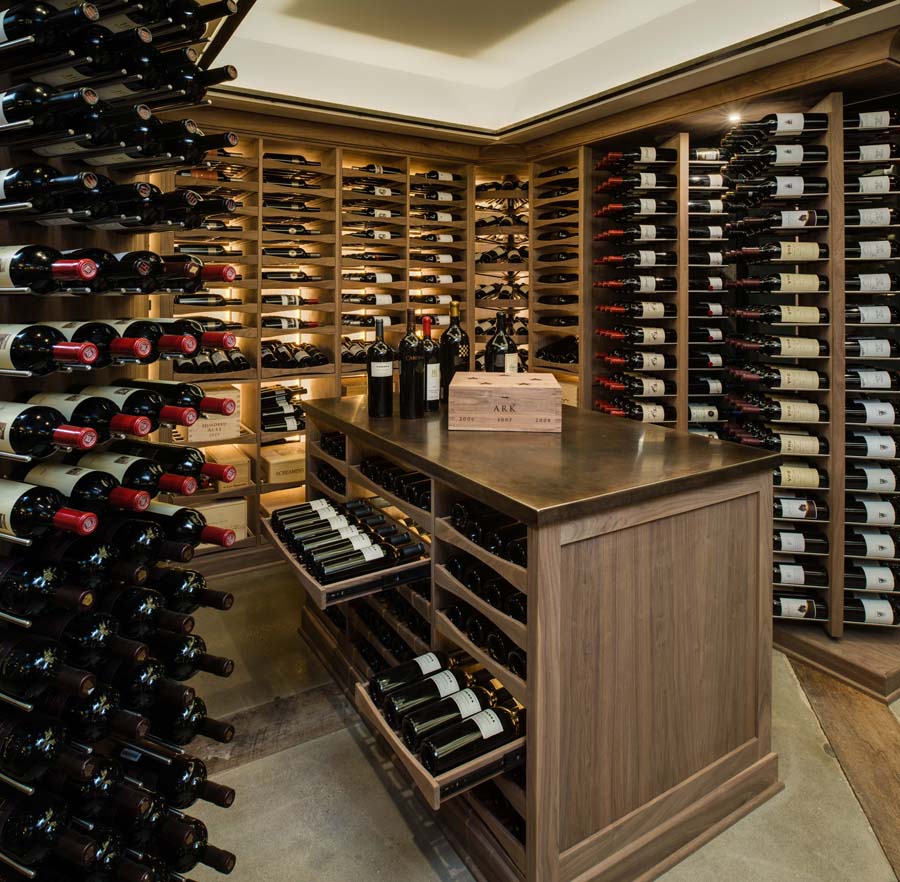VINO COLLECTORS ARE KNOWN FOR THEIR SOPHISTICATED PALATES, SO IT ONLY MAKES SENSE THAT THEY’RE DEMANDING TASTEFUL WAYS TO PROTECT AND PRESERVE THEIR BEST BOTTLES
By Laura Kostelny
As Heritage Auctions’ Senior Director of Fine & Rare Wine, Frank Martell is used to fielding questions from collectors. But whether the buyer is a Burgundy devotee, port sipper or Champagne aficionado, he says they all share a top concern: how to keep their wines safe. While some may consider investing in a faraway cave or a medieval property, Martell says that’s not necessary. “Yes, there’s a certain romance about drinking wines that have been stored in a castle cellar, but the castle isn’t the magical part of that equation,” he explains. “A cellar, built of stone, set in the earth, will be naturally moist and very slow to change temperature, if there is any fluctuation at all.”
There’s a certain romance about drinking wines that have been stored in a castle cellar, but the castle isn’t the magical part of that equation.”
–Frank Martell, Senior Director of Fine & Rare Wine, Heritage Auctions
While he allows that nothing is better than a purpose-built space constructed from materials that help maintain a constant environment, Martell says that most wine-specific refrigeration units will do a good job of maintaining a steady temperature that keeps bottles safe for short-term aging. The LG SIGNATURE Wine Cellar, for example, is designed to create the conditions of traditional wine caves and comes with all kinds of bells and whistles, including temperature controls, vibration controls and an optimal humidity control. Likewise, Zephyr offers a series of wine coolers with similar features. Besides maintaining steady temperatures and humidity, the coolers are designed to minimize vibration and UV light.
Enlarge

Photo courtesy LG
► Wine Storage 101
No matter where you keep your collection, Heritage’s Frank Martell says these are the tips you should always remember:
- Wines need to be kept between 48 and 65 degrees at a steady and stable temperature.
- Wines do not like light or vibration, but they do like constant 70 percent humidity.
- A wine fridge like you would find at a department store or home improvement store should be sufficient for anything you want to keep for a short while (just a few years).
- Old and rare wines are more delicate and require more obsessive attention to storage conditions, but young, robust wines are generally going to be resilient to minor variation in temperature.
- It is better for wine to be stored at a constant 65 degrees than have it bouncing between 45 and 60 on a daily basis. The rate at which temperatures fluctuate is as dangerous as extreme high and low temperatures.
“If someone has wines that they plan to keep for quite a few years, or older, fragile wines that are more likely to be affected by temperature fluctuation, those wines deserve a unit that includes careful humidity control,” Martell says. “Wines that are 25-plus years old begin to be a little bit more vulnerable to changes in environment. They will not be adversely affected by a door opening and closing, but they are less resilient to changes in temperature and humidity.”
Martell goes on to say that the single most important factor in wine storage is maintaining a constant temperature. Bottles stored at a less-than-ideal temperature that is kept steady will age more gracefully than wines that bounce between 45 to 60 degrees over and over again. “That rule applies to all wines,” he notes. “Steady and appropriate humidity is also important for long-term storage, so a digital thermometer that records high and low temps with average humidity is a necessity.”
Funny enough, the advice presented by those circa 1939 prewar posters, “Keep Calm and Carry On,” is also useful in wine preservation. Says Martell: “Light and vibration are both enemies of calm rest. People will often place a stand-alone wine space in a room so that the door faces in a way that sunlight pours onto the surface. That will certainly affect the consistency of the ambient temperature inside the cellar, and even if the max temperature never exceeds 60 degrees, a bouncing environment will not keep a wine healthy over the long term.”
While matters of temperature, humidity and vibration are paramount, many serious collectors also work with their interior designers, contractors and professionals like wine cellar specialist Jim Cash to create a display that shows off their prized finds, keeps the bottles safe and works well with the home’s overall aesthetic. Cash has been an avid wine collector for 35 years – he has even bought a bottle or two from Heritage Auctions – and his frustration at trying to find specific wine-storage features led him to design his own system. “I wanted a series of pull-out drawers so that with one simple movement, I could look at the labels of five or six bottles at one time,” he says. “I wanted all my labels to be presented right side up instead of upside down.”
Enlarge

Photo by Mike Gullon
Cash used his experience in construction to design his cellar. “I just made up the whole thing – the dowel bottoms, the pull-out drawers – and because I wanted to find a way to use the space that happens in the corner void, I created a wheel system designed to hold wine bottles,” he says. “I buy wine by the case, so I also needed multipurpose drawers where I could put the whole lot.” Once fellow collectors caught wind of his sophisticated storage system, they wanted one, too. Thus, Revel Custom Wine Cellars was born, and over the past 15 years, Cash has constructed some 350 custom cellars in homes all over the United States and beyond.
For those looking for a more hands-on alternative, Millesime Wine Racks offers high-quality and safe display systems in both solid wood and acrylic with black or clear anodized aluminum support. Their user-friendly website makes it easy to place an order based on the size of your collection, and depending on stock availability, you’ll have racks in four to six weeks. You can also contact them directly for a free design to specs of your wine cellar. “The beauty of the Millesime system is that it’s easy to set up since the vertical posts come pre-cut to the proper height of each space, pre-drilled and ready to receive our pre-assembled shelves. In short, any handyman can assemble them,” says Millesime sales rep Jean-Yves André.
Enlarge

Photo courtesy Millesime Wine Racks
Of course, you can do everything right when storing your wine, and things can still go wrong, such as fire, burglary or accidental breakage. That’s where having insurance comes in handy. James Appleton of MiniCo Insurance Agency says getting a policy is pretty straightforward for the average collector. “They would normally get an onus of proof policy,” he explains. “Every program is different, but the minimum is a $150 yearly premium that covers maybe $15,000 to $20,000 worth of wine. Then if something happens, and they say they’ve got $50,000 worth of wine, the onus of proof – receipts, proof of provenance and so on – is on them when they file a claim.”
But Appleton warns that things like flavor irregularity or a cork drying out aren’t grounds for a claim. “That’s improper care on the part of the collector,” he says. “We’re not going to cover equipment breakdown. If you have a climate-controlled cellar, it’s up to you to maintain your equipment.” Appleton also notes that in the event of a claim, MiniCo’s policy would pay full collectible value, not actual cash value like a typical homeowners policy, so it’s important to regularly verify the value of the collection and endorse the policy as needed to ensure adequate coverage.
Heritage’s next Wine auction takes place March 17 in Beverly Hills. For inquiries, contact Frank Martell at 310.492.8616 or FrankM@HA.com.
LAURA KOSTELNY is a contributor to Intelligent Collector.

